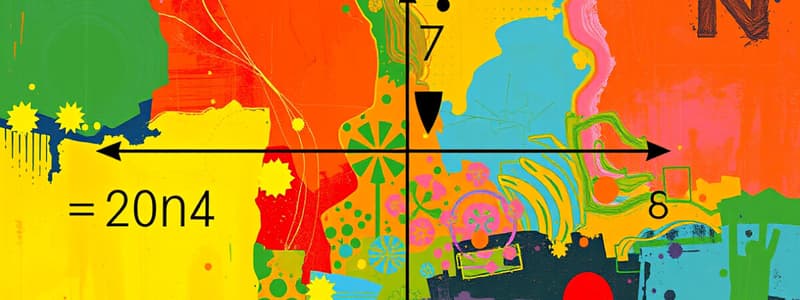Podcast
Questions and Answers
What is the primary function of the utility function in traditional economics?
What is the primary function of the utility function in traditional economics?
- To establish the parameters of the value function
- To represent happiness based on consumption (correct)
- To calculate expected utility under uncertainty
- To replace subjective probabilities
What modification did Kahneman and Tversky introduce to the expected utility theory?
What modification did Kahneman and Tversky introduce to the expected utility theory?
- They combined utility functions with risk assessments
- They applied linear functions to economic behavior
- They introduced a value function with a kink (correct)
- They eliminated the utility function entirely
How does the value function differ from the traditional utility function when plotting gains and losses?
How does the value function differ from the traditional utility function when plotting gains and losses?
- It is concave downward for both gains and losses
- It exhibits constant marginal utility across all values
- It is concave upward for losses and has a kink at the origin (correct)
- It treats gains and losses the same without distinction
What do indifference curves represent in traditional utility theory?
What do indifference curves represent in traditional utility theory?
In the context of expected utility theory, what is meant by 'maximized expected utility'?
In the context of expected utility theory, what is meant by 'maximized expected utility'?
What aspect of probabilities did Kahneman and Tversky alter in their version of expected utility theory?
What aspect of probabilities did Kahneman and Tversky alter in their version of expected utility theory?
What characteristic does the traditional utility function exhibit regarding marginal utility?
What characteristic does the traditional utility function exhibit regarding marginal utility?
What is the significance of the 'kink' in the value function proposed by Kahneman and Tversky?
What is the significance of the 'kink' in the value function proposed by Kahneman and Tversky?
What is the significance of the reference point in relation to utility?
What is the significance of the reference point in relation to utility?
How do individuals typically respond to small bets according to the concept of reference points?
How do individuals typically respond to small bets according to the concept of reference points?
In the coin toss example, why was E Cary Brown hesitant to accept the offer made by Samuelson?
In the coin toss example, why was E Cary Brown hesitant to accept the offer made by Samuelson?
What psychological concept explains why people might decline small bets even when they have a positive expected value?
What psychological concept explains why people might decline small bets even when they have a positive expected value?
What does the term 'kink' refer to in the context of the value function discussed?
What does the term 'kink' refer to in the context of the value function discussed?
How does one's reference point affect decision-making over time?
How does one's reference point affect decision-making over time?
What is implied by the claim that people are willing to take large risks to escape losses?
What is implied by the claim that people are willing to take large risks to escape losses?
How does the concept of expected utility theory suggest one should behave with positive expected value bets?
How does the concept of expected utility theory suggest one should behave with positive expected value bets?
What was Paul Samuelson's conclusion about E Cary Brown's behavior regarding the coin toss gamble?
What was Paul Samuelson's conclusion about E Cary Brown's behavior regarding the coin toss gamble?
What role does the origin's movement through time play in the concept of utility?
What role does the origin's movement through time play in the concept of utility?
Flashcards are hidden until you start studying
Study Notes
Core Economic Theories
- Expected utility theory posits that individuals make choices to maximize their utility based on a utility function tied to their consumption and happiness.
- Indifference curves represent contours for the utility function, illustrating consumer preferences and choices without uncertainty.
Kahneman and Tversky's Contributions
- Introduced a value function, replacing the traditional utility function to better capture human decision-making.
- Shifted from objective probabilities to subjective probabilities, utilizing a weighting function to assess actual chances.
Value Function Characteristics
- The value function features a kink at the reference point, with different slopes for gains and losses.
- Unlike utility functions that exhibit diminishing marginal utility consistently, the value function highlights psychological factors in decision-making.
Reference Point Framework
- Decisions are influenced by a dynamic reference point, which shifts based on individual circumstances, reflecting how people perceive current financial situations.
- Gains and losses are evaluated relative to this reference point, highlighting the subjective nature of economic judgments.
Behavioral Implications
- People often avoid small bets, despite expected utility theory suggesting otherwise; decision-making is influenced by perceived risks and psychological comfort.
- An example involves a proposed coin toss bet, wherein an individual declines a small bet with positive expected value but accepts the same bet repeated multiple times due to the law of large numbers.
Human Decision-Making Traits
- The kink in the value function emphasizes that individuals perceive losses more acutely than equivalent gains, leading to risk-averse behavior in small stakes.
- People are often willing to take significant risks when attempting to avoid losses, showcasing a psychological bias in economic behavior.
Studying That Suits You
Use AI to generate personalized quizzes and flashcards to suit your learning preferences.




